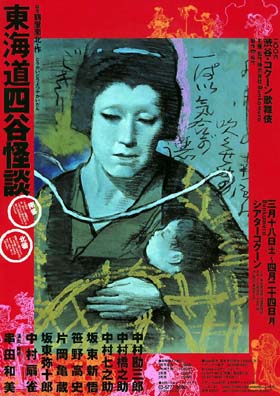| APRIL 2006 |
|
3 shows in T˘ky˘ (Kabukiza, Theatre Cocoon), 1 in Nagoya (Misonoza), 3 in ďsaka (Sh˘chikuza), 2 in Ky˘to (Minamiza, Daigoji), and 2 on Shikoku island (Kanamaruza)!
|
| Kabukiza (T˘ky˘) |  |
| Dates | 1 ~ 25 April 2006 (Shigatsu ďkabuki) |
| MatinÚe |
Takao Kanhasshű Tsunagi Uma |
| Evening | |
| Casting |
Nakamura Jakuemon, Onoe Kikugor˘, Kataoka Nizaemon, Nakamura Kichiemon, Nakamura Tomijűr˘, Nakamura Shikan, Nakamura Tokiz˘, Sakata T˘jűr˘, Nakamura Baigyoku, Nakamura Kaishun, Kataoka Gat˘, Kataoka Hidetar˘, Nakamura Fukusuke, Ichikawa Sadanji, Nakamura T˘z˘, Nakamura Matsue, Nakamura Kantar˘, Nakamura Tamatar˘ |
| Comments |
This April program commemorates the 5th anniversary (6th memorial service) of the death of Nakamura Utaemon VI. It also celebrates the shűmei of Nakamura Matsue VI and the first stage appearance of his son, who receives the name of Nakamura Tamatar˘ V. The new Matsue plays the roles of Minamoto no Yorihira and Imada Manjir˘ in "Kanhasshű Tsunagi Uma" and "Ise Ondo Koi no Netaba"; his son Tamatar˘ plays the role of the child Umematsu in the former play.
|
|
|||
| Dates | 1 ~ 24 April 2006 | ||
| Program | T˘kaid˘ Yotsuya Kaidan | ||
| Casting |
Nakamura Kanzabur˘, Nakamura Hashinosuke, Nakamura Senjaku, Band˘ Yajűr˘, Kataoka Kamez˘, Nakamura Shichinosuke, Band˘ Shingo, Sasano Takashi |
||
| Comments | Seventh edition of the original Cocoon Kabuki performance, which recreates the atmosphere of the Edo koshibai and brings the actors closer to the audience. Tsuruya Nanboku IV's masterpiece "T˘kaid˘ Yotsuya Kaidan" is staged in 2 different productions; the first one is similar to the 1994 Coocon Kabuki, with Nakamura Kanzabur˘ playing the roles of Oiwa, Kobotoke Kohei and Sat˘ Yomoshichi, while Nakamura Hashinosuke plays the role of Tamiya Iemon; the second version includes the rarely-staged act IV, with its 2 scenes "the Misumi House in Fukagawa" and "the Refuge of the Oshioda Family", with Nakamura Kanzabur˘ playing the roles of Oiwa and Naosuke Gonbŕ, sharing the stage with Nakamura Hashinosuke (Tamiya Iemon, Oshioda Matanoj˘) and Nakamura Senjaku (Kobotoke Kohei, Sat˘ Yomoshichi). | ||
 |
|||
| Misonoza (Nagoya) |  |
| Dates | 1 ~ 25 April 2006 (Y˘shun ďkabuki) |
| Program | |
| Casting |
Matsumoto K˘shir˘, Nakamura Shibajaku, Ichikawa Somegor˘, Ichikawa Komaz˘, Nakamura Karoku, Matsumoto Kingo, Kataoka Kamez˘, Band˘ Kametoshi |
| Comments |
The highlight of this April program in Nagoya is the beautiful dance "Kitsunebi", starring Nakamura Shibajaku in the difficult role of Princess Yaegaki.
|
| Kanamaruza (Konpira) |
| Dates | 6 ~ 23 April 2006 (Shikoku Konpira Kabuki ďshibai) |
| MatinÚe |
Tsuki Yuki Hana Nagori no Bundai
|
| Evening |
|
| Casting |
Band˘ Mitsugor˘, Ichikawa Ebiz˘, Ichikawa Kamejir˘, Ichimura Kakitsu, Ichikawa Unosuke, Kataoka Ichiz˘, Band˘ Shűch˘ |
| Comments |
22nd edition of the Spring Kabuki performance Konpira Kabuki ďshibai at the Kanamaruza on Shikoku Island.
|
| Sh˘chikuza (ďsaka) |
| Dates | 4 ~ 11 April 2006 (Naniwa Hanagata Kabuki) |
| MatinÚe | |
| Afternoon |
Osome Hisamatsu Ukina no Yomiuri |
| Evening |
Naniwa S˘j˘ki (ďshio Heihachir˘) |
| Casting |
Nakamura Kanjaku, Kataoka Takatar˘, Kataoka Ainosuke, Band˘ Takesabur˘, Nakamura Kikaku, Band˘ Shinsha, Kataoka Shinnosuke, Kamimura Kichiya |
| Comments |
3rd edition of the Naniwa Hanagata Kabuki April program, staged by a troupe of young Kamigata actors. The first program includes rarely-staged scenes. The third program is a newly-created drama.
|
| Daigoji Temple (Ky˘to) | |
| Dates | 27 ~ 29 April 2006 (Daigoji Takigi Kabuki) |
| Program |
Ch˘gen Sh˘nin Yurai Kagami Sait˘ Goma | Hiire no Gi | Sh˘my˘ |
| Casting |
Nakamura Tomijűr˘, Nakamura Hashinosuke, Kataoka Takatar˘, Kataoka Ainosuke |
| Comments |
Original outdoors Kabuki performance, in the precincts of the famous Daigoji temple which is located on mount Atago. This performance mixes religious ceremonies and Kabuki dances. The first item commemorates Saint Ch˘gen. |
|
|||
| Dates | 19 ~ 25 April 2006 (Kabuki Kansh˘ Ky˘shitsu) | ||
| Program |
Minamiza to Kabuki |
||
| Casting | Kamimura Kichiya | ||
| Comments |
14th edition of a pedagogical show in Ky˘to combining explanation for beginners (done by the professional storyteller Katsura Kujaku) and a dance-drama (performed by Kamimura Kichiya). |
||
|
|
| Contact | Main | Top | Updates | Actors | Plays | Playwrights | Programs | Links | FAQ | Glossary | Chronology | Illustrations | Prints | Characters | Derivatives | Theaters | Coming soon | News |
